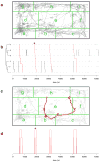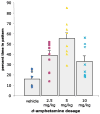A novel method for automatic quantification of psychostimulant-evoked route-tracing stereotypy: application to Mus musculus
- PMID: 18097652
- PMCID: PMC2562621
- DOI: 10.1007/s00213-007-0994-6
A novel method for automatic quantification of psychostimulant-evoked route-tracing stereotypy: application to Mus musculus
Abstract
Rationale: Route-tracing stereotypy is a powerful behavioral correlate of striatal function that is difficult to quantify. Measurements of route-tracing stereotypy in an automated, high throughput, easily quantified, and replicable manner would facilitate functional studies of this central nervous system region.
Objective: We examined how t-pattern sequential analysis (Magnusson Behav Res Meth Instrum Comput 32:93-110, 2000) can be used to quantify mouse route-tracing stereotypies. This method reveals patterns by testing whether particular sequences of defined states occur within a specific time interval at a probability greater than chance.
Results: Mouse home-cage locomotor patterns were recorded after psychostimulant administration (GBR 12909, 0, 3, 10, and 30 mg/kg; d-amphetamine, 0, 2.5, 5, and 10 mg/kg). After treatment with GBR 12909, dose-dependent increases in the number of found patterns and overall pattern length and depth were observed. Similar findings were seen after treatment with d-amphetamine up to the dosage where focused stereotypies dominated behavioral response. For both psychostimulants, detected patterns displayed similar morphological features. Pattern sets containing a few frequently repeated patterns of greater length/depth accounted for a greater percentage of overall trial duration in a dose-dependant manner. This finding led to the development of a t-pattern-derived route-tracing stereotypy score. Compared to scores derived by manual observation, these t-pattern-derived route-tracing stereotypy scores yielded similar results with less within-group variability. These findings remained similar after reanalysis with removal of patterns unmatched after human scoring and after normalization of locomotor speeds at low and high ranges.
Conclusions: T-pattern analysis is a versatile and robust pattern detection and quantification algorithm that complements currently available observational phenotyping methods.
Figures





References
-
- Bäck T. Evolutionary algorithms in theory and practice—evolution strategies, evolutionary programming, genetic algorithms. Oxford University Press; Oxford, UK: 1996.
-
- Bakeman R, Gottman JM. Observing interaction. An introduction to sequential analysis. Cambridge University Press; Cambridge UK: 1997.
-
- Barwick VS, Jones DH, Richter JT, Hicks PB, Young KA. Subthalamic nucleus microinjections of 5-HT2 receptor antagonists suppress stereotypy in rats. Neuroreport. 2000;11:267–270. - PubMed
-
- Borrie A, Jonsson GK, Magnusson MS. Temporal pattern analysis and its applicability in sport: an explanation and exemplar data. J Sports Sci. 2002;20:845–852. - PubMed
Publication types
MeSH terms
Substances
Grants and funding
LinkOut - more resources
Full Text Sources
Other Literature Sources

